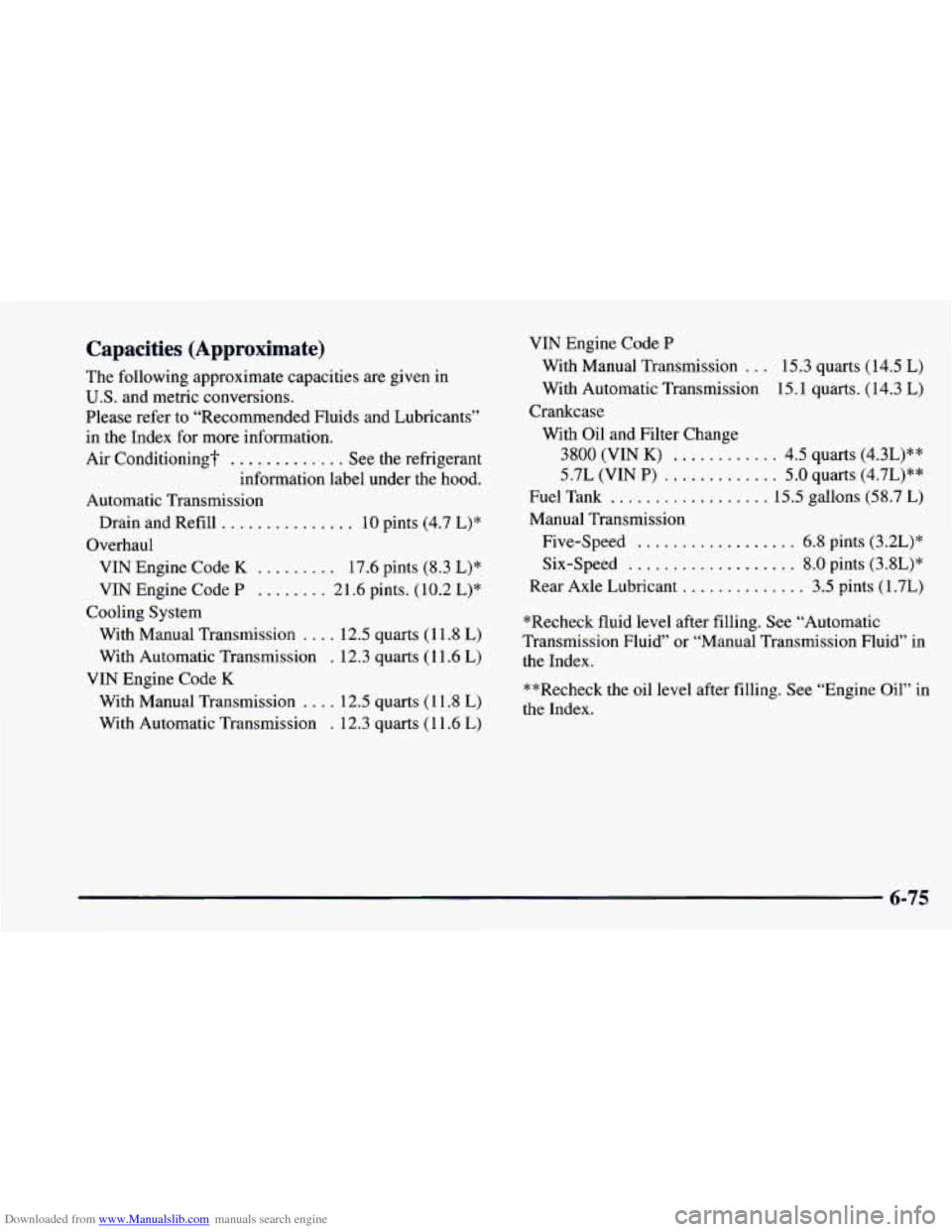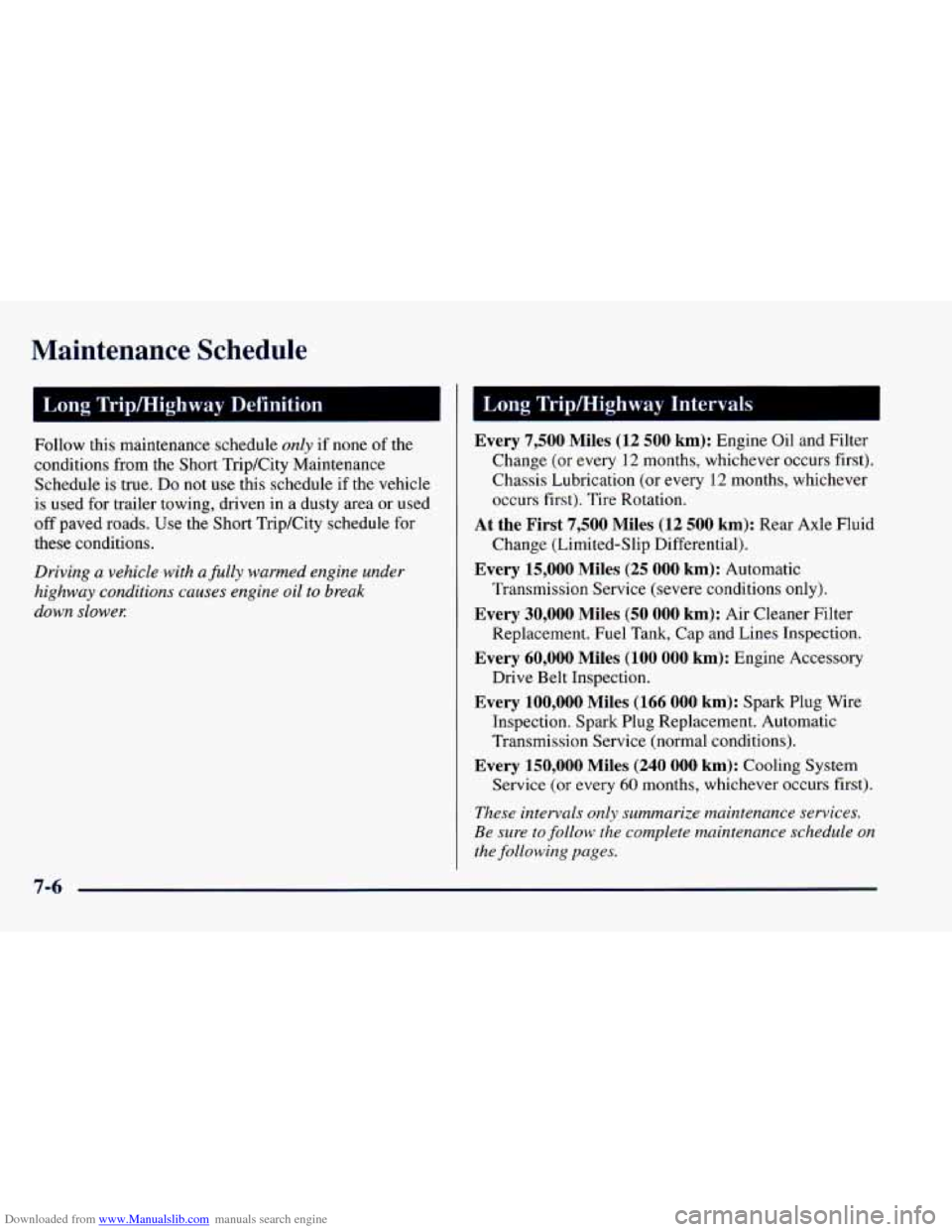Page 253 of 404
Downloaded from www.Manualslib.com manuals search engine While refueling, hang the cap inside the fuel door.
To take off the cap, turn it slowly to the left
(counterclockwise).
If you get gasoline on yourself and then
something ignites it, you could be badly burned.
Gasoline can spray out on you
if you open the
fuel filler cap too quickly. This spray can happen
if your tank is nearly full, and is more likely in
hot weather. Open the fuel filler cap
slowly and
wait for any “hiss” noise
to stop. Then unscrew
the cap all the
way.
Be careful not to spill gasoline. Clean gasoline from
painted surfaces as soon as possible. See “Cleaning the
Outside of Your Chevrolet” in the Index.
6-7
Page 254 of 404

Downloaded from www.Manualslib.com manuals search engine When you put the cap back on, turn it to the right
(clockwise) until you hear a clicking sound. Make sure
you fully install the cap. The diagnostic system can
determine
if the fuel cap has been left off or improperly
installed. This would allow fuel to evaporate into the
atmosphere. See “Malfunction Indicator Lamp” in
the Index.
NOTICE:
If you need a new cap, be sure to get the right
type. Your dealer can get one for you.
If you get
the wrong type,
it may not fit or have proper
venting,
and your fuel tank and emissions system
might be damaged.
Checking Things Under the Yood
- -
An electric fan under the hood can start up and
injure you even when the engine
is not running.
Keep hands, clothing and tools
away from any
underhood electric fan.
I /A CAUTION:
Things that burn can get on hot engine parts and
start a fire. These include liquids like gasoline,
oil, coolant, brake fluid, windshield washer and
other fluids, and plastic or rubber. You or others
could be burned. Be careful not
to drop or spill
things that will burn onto
a hot engine.
Page 258 of 404
Downloaded from www.Manualslib.com manuals search engine Before closing the hood, be sure all the filler caps
are on.
Then just pull the hood down and close it firmly.
Engine Oil
If the LOW OIL light
on the instrument panel
comes on, it means you
need
to check your engine
oil level right away.
LOW OIL
For more information, see “Low Oil Light” in the Index.
You should check your engine oil level regularly; this is
an added reminder.
It’s a good idea
to check your engine oil every time you
get fuel. In order
to get an accurate reading, the oil must
be warm and the vehicle must be on level ground.
3800 Engine Oil Dipstick
The engine oil dipstick is the yellow loop near the back
of the engine
6-12
Page 320 of 404

Downloaded from www.Manualslib.com manuals search engine Replacement Bulbs
Back-up ............................... 1141
Center High-Mounted Stoplamp
............. 92 1
Front Parking and Turn Signal ............. 3 157K
Headlamp (Low-Beam) ................. H-435 1
Headlamp (High-Beam)
................ H-4352
Sidemarker
.............................. 194
Tail Only
............................... 194
Tail/Stop/Turn
.......................... 2057
Capacities and Specifications
Engine
Type VIN Engine Code
K ...................... V6
VIN Engine Code P
...................... V8
Fuel Delivery
.................... Fuel Injection
Valve Arrangement
.................... In-Head
Piston Displacement VIN Engine Code
K ............ 23 1 CID (3800)
VIN Engine Code P ............ 350 CID (5.7L)
VIN Engine Code K .............. 1-6-5-4-3-2
VIN Engine Code P ........... 1-8-4-3-6-5-7-2
Wheel Nut Torque ........... 100 lb-ft (140 N-m)
Thermostat Temperature Specification
180°F (82°C)
Windshield Wiper Blade Replacement
Type
................................. hook
Length ................... 24 inches (610 mm)
Firing Order
6-74
Page 321 of 404

Downloaded from www.Manualslib.com manuals search engine Capacities (Approximate)
The following approximate capacities are given in
U.S. and metric conversions.
Please refer to “Recommended Fluids and Lubricants”
in the Index for more information.
Air Conditioning?
............. See the refrigerant
information label under the hood.
Automatic Transmission
Drain and Refill
............... 10 pints (4.7 L)*
Overhaul VIN Engine Code
K ......... 17.6 pints (8.3 L)*
VIN Engine Code P ........ 21.6 pints. (10.2 L)*
With Manual Transmission
.... 12.5 quarts (1 1.8 L)
With Automatic Transmission
. 12.3 quarts (1 1.6 L)
With Manual Transmission
.... 12.5 quarts (1 1.8 L)
With Automatic Transmission
. 12.3 quarts (1 1.6 L)
Cooling System
VIN Engine Code
K
VIN Engine Code P
With Manual Transmission
... 15.3 quarts (14.5 L)
With Automatic Transmission 15.1 quarts. (14.3 L)
With Oil and Filter Change
Crankcase
3800 (VIN K) ............ 4.5
quarts (4.3L)**
5.7L (VIN
P) ............. 5.0 quarts (4.7L)**
Fuel Tank .................. 15.5 gallons (58.7 L)
Manual Transmission
Five-Speed
.................. 6.8 pints (3.2L)*
Six-Speed
................... 8.0 pints (3.8L)*
Rear Axle Lubricant
.............. 3.5 pints (1.7L)
*Recheck fluid level after filling. See “Automatic
Transmission Fluid” or “Manual Transmission Fluid” in
the Index.
**Recheck the oil level after filling. See “Engine
Oil” in
the Index.
6-75
Page 322 of 404

Downloaded from www.Manualslib.com manuals search engine Vehicle Dimensions
Length .................. 193.2 inches (49 1 cm)
Width
.................... 74.1 inches (1 89 cm)
Height Wheelbase
.............. 101.1 inches (257 cm)
Front Tread
.............. 60.7 inches (154 cm)
Replacement Parts
Air Cleaner Filter ...................... A1 163C
Battery
................................ 75-60
Engine Oil Filter VIN Engine Code
K .................... PF47
VIN Engine Code P
.................... PF25
Fuel Filter
............................. GF578
PCV Valve VIN Engine Code
K ................. CV892C
VIN Engine Code P
................. CV895C
Radiator Cap
........................... RC24
Spark Plug
VIN Engine Code
K ....... -41-921 (0.060' Gap)
VIN Engine Code P ....... -41-943 (0.050' Gap)
Air Conditioning Refrigerants
Not all air conditioning refrigerants are the same.
If the air conditioning system in
your vehicle needs
refrigerant, be sure the proper refrigerant is used.
If you're not sure, ask your Chevrolet dealer.
6-76
Page 329 of 404

Downloaded from www.Manualslib.com manuals search engine Maintenance Schedule
Short TriplCity Definition
Follow the Short Trip/City Maintenance Schedule if any
one of these conditions
is true for your vehicle:
Most trips are less than 5 to 10 miles (8 to 16 km).
This is particularly important when outside
temperatures are below freezing.
Most trips include extensive idling (such as frequent
driving in stop-and-go traffic).
Most trips are through dusty areas.
You frequently tow a trailer or use a carrier on top of
If the vehicle is used for delivery service, police, taxi
One of the reasons you should follow this schedule if
you operate your vehicle under any of these conditions
is that these conditions cause engine oil to
break
down soonex
your vehicle.
or other commercial application.
Short Trip/City Intervals
Every 3,000 Miles (5 000 km): Engine Oil and Filter
Change (or
3 months, whichever occurs first).
Every 6,000 Miles (10 000 km): Chassis Lubrication
(or
6 months, whichever occurs first). Tire Rotation.
Every 6,000 Miles (10 000 km) of Trailering: Rear
Axle Fluid Change (Vehicles Towing Trailers).
At the First 6,000 Miles (10 000 km): Rear Axle Fluid
Change (Limited-Slip Differential).
Every 15,000 Miles (25 000 km): Air Cleaner Filter
Inspection, if driving in dusty conditions. Automatic
Transmission Service (severe conditions only).
Every 30,000 Miles (50 000 km): Air Cleaner Filter
Replacement. Fuel Tank, Cap and Lines Inspection.
Every 60,000 Miles (100 000 km): Engine Accessory
Drive Belt Inspection.
Every 100,000 Miles (166 000 km): Spark Plug Wire
Inspection. Spark Plug Replacement. Automatic
Transmission Service (normal conditions).
Every 150,000 Miles (240 000 km): Cooling System
Service (or every
60 months, whichever occurs first).
These intervals only summarize maintenance services.
Be
sure to follow the complete maintenance schedule on
the following pages.
Page 330 of 404

Downloaded from www.Manualslib.com manuals search engine Mainte- Ice Schedule
Follow this maintenance schedule only if none of the
conditions from the Short Trip/City Maintenance
Schedule is true. Do not
use this schedule if the vehicle
is used for trailer towing, driven in a dusty area or used
off paved roads. Use
the Short Trip/City schedule for
these conditions.
Driving a vehicle with a fully warmed engine under
highway conditions causes engine oil
to break
down slower:
I Long TripHighway
Every 7,500 Miles (12 500 km): Engine Oil and Filter
Change (or every
12 months, whichever occurs first).
Chassis Lubrication (or every
12 months, whichever
occurs first). Tire Rotation.
At the First 7,500 Miles (12 500 km): Rear Axle Fluid
Change (Limited-Slip Differential).
Every 15,000 Miles (25 000 km): Automatic
Transmission Service (severe conditions only).
Every 30,000 Miles (50 000 km): Air Cleaner Filter
Replacement. Fuel Tank, Cap and Lines Inspection.
Every 60,000 Miles (100 000 km): Engine Accessory
Drive Belt Inspection.
Every 100,000 Miles (166 000 km): Spark Plug Wire
Inspection. Spark Plug Replacement. Automatic
Transmission Service (normal conditions).
Every 150,000 Miles (240 000 km): Cooling System
Service (or every
60 months, whichever occurs first).
Intervals
These intervnls only summarize maintenance services.
Be sure to follow the complete maintenance schedule
on
the following pclges.
7-6